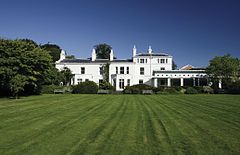Uttley House
| Uttley House | |
|---|---|
 The original Firs section | |
 | |
| Former names | The Firs, Chancellors Hotel & Conference Centre |
| General information | |
| Location | Fallowfield Campus |
| Address | Chancellors Way,Fallowfield,Manchester |
| Coordinates | 53°26′37″N2°12′48″W/ 53.443611°N 2.213333°W |
| Completed | 1850 |
| Owner | University of Manchester |
| Design and construction | |
| Architect(s) | Edward Walters |
| Designations | |
Listed Building– Grade II | |
| Official name | The Firs and attached annex |
| Designated | 2 October 1974 |
| Reference no. | 1270605 |
Listed Building– Grade II | |
| Official name | Lodge of The Firs, with attached gateway |
| Designated | 2 October 1974 |
| Reference no. | 1254834 |
Uttley House(formerly namedThe Firs), is aGrade II listedbuilding andhalls of residenceinFallowfield,Manchester,England. It was designed and built in 1850 byEdward Walters,who was also responsible for Manchester'sFree Trade Hall.The building is named after English writerAlison Uttley.It was originally built forSir Joseph Whitworth;the house was later the home ofC. P. Scott,editor of theManchester Guardian.It is surrounded by 5.5 acres (2.2 ha) of gardens to the south and an environmental research institute to the north. The house has seen many past uses, including a private home, hotel, vaccination clinic and conference centre.
History
[edit]The Firs
[edit]Whitworth used The Firs mainly as a social, political and business base, entertaining radicals of the age such asJohn Bright,Richard Cobden,William ForsterandT. H. Huxleyat the time of theReform Billof 1867. Whitworth, credited with raising the art ofmachine-toolbuilding to a previously unknown level, supported the newMechanics InstituteinManchester— the birthplace ofUMIST— and helped to found the Manchester School of Design. To the rear, Whitworth had a shooting range — now the site of the University's horticultural glasshouses — on which he tested his famous, but commercially unsuccessful, Whitworth Rifle, which featured a revolutionaryhexagonallyrifled barrel. The house was surrounded by a 52 acres (21 ha) estate that now makes up the currentFallowfield Campus.[1]
In 1882, having built a new house inDarley Dale,Whitworth leased The Firs to his friendC.P. Scott,editor of theManchester Guardian.[1]After Scott's death the house became the property of theUniversity of Manchester,and was the vice-chancellor's residence until 1991. The house is aGrade II listed building.[2]
Hotel
[edit]The house was converted into a hotel and re-opened as theChancellors Hotel & Conference Centrein 1997. A large extension to the Grade II building was completed for the hotel, giving it a capacity of 72 rooms. The hotel was operated by theuniversity's events venue arm as a conference centre and featured a restaurant, bar and conference facilities.[3]Operations ceased in 2019, as the university prepared to repurpose the site as part of the university's redevelopment of the existing buildings on the campus.[4][5]
During theCOVID-19 pandemic,the former hotel site was used as avaccinationcentre.[6]
Halls of residence
[edit]
In 2021, as part of a redevelopment of the Fallowfield Campus, the hotel was converted into a student hall of residence and renamed Uttley House, after writerAlison Uttley.[7]The halls of residenceJunior Common Roomis shared with Richmond Park, another hall of residence to the north.[8]
Firs Environmental Research Station
[edit]Included in the site formerly part of The Firs is theFirs Environmental Research Station,a research institute of theDepartment of Earth and Environmental Sciences.[9]During World War I, various drugs were grown and developed at the station, includingAtropa belladonnaandHyoscyamus niger.[10]The facility houses an air quality monitoring station, greenhouses, climate controlled growing environments and remnants of the old botanical garden.
In 2020, as a result of a £2 million endowment, the greenhouses were substantially upgraded.[11]
See also
[edit]References
[edit]- ^abHistory (Faculty of Life Sciences - The University of Manchester)Archived7 October 2006 at theWayback Machine
- ^Historic England."The Firs and attached annex (Grade II) (1270605)".National Heritage List for England.Retrieved19 August2023.
- ^"Details (The University of Manchester)".conference.manchester.ac.uk.The University of Manchester. 30 May 2022. Archived fromthe originalon 30 May 2022.Retrieved30 May2022.
- ^"Contract out for Owens Park construction partner".Place North West.5 June 2015.Retrieved30 May2022.
- ^"Fallowfield residential development | Campus Masterplan | The University of Manchester".masterplan.manchester.ac.uk.The University of Manchester.Retrieved30 May2022.
- ^"Wayback Machine"(PDF).healthiermanchester.org.Healthier Manchester. Archived fromthe original(PDF)on 30 May 2022.Retrieved30 May2022.
- ^"Details (The University of Manchester)".accommodation.manchester.ac.uk.The University of Manchester.Retrieved29 May2022.
- ^"Official Richmond Park & Uttley House University of Manchester 2021 | Facebook".facebook.Retrieved30 May2022.
- ^"The Firs environmental research station - Department of Earth and Environmental Sciences - The University of Manchester".ees.manchester.ac.uk.The University of Manchester.Retrieved30 May2022.
- ^"The fascinating history - and future - of FIRS Environmental Research Station".eps.manchester.ac.uk.The University of Manchester. 3 December 2020.Retrieved30 May2022.
- ^"FIRS Environmental Research Centre gets £2m makeover".eps.manchester.ac.uk.The University of Manchester. 15 October 2020.Retrieved30 May2022.





